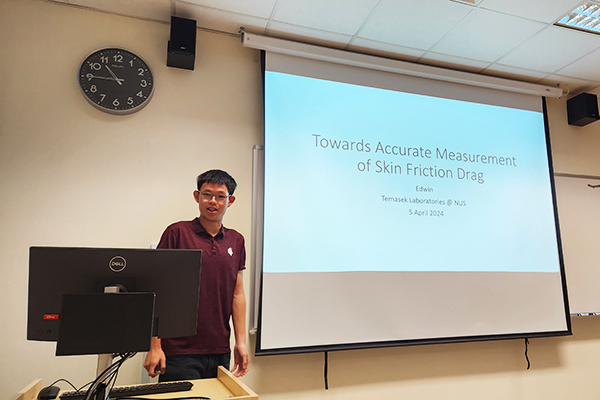
Towards Accurate Measurements of Skin Friction Drag Reduction over a Flat Plate with Plasma Actuator(s) |
| 5 April 2024, Friday, 10:30 - 11:00am | Speaker: Mr. Edwin Setiadi Sugeng, PhD Student, Department of Mechanical Engineering, NUS |
| Venue: Seminar Room 8D-1, Level 8, Temasek Laboratories | Event Organiser Host: Dr. Huang Xin |

ABSTRACT |
Plasma-assisted flow separation control using dielectric barrier discharge (DBD) actuators has attracted widespread research interest over the past two decades. Reasons for this attractiveness include a lack of moving parts, large actuation bandwidth, and an ability to be flush-mounted onto any surface, such that the baseline flow remains virtually unperturbed in the absence of plasma actuation. The main disadvantages of this approach include an inability to effect significant and efficient momentum transfer to the freestream flow, as well as its susceptibility to generating electromagnetic interference (EMI). The former has limited the use of these devices to low-speed applications, where the Reynolds number is low. More recently however, there has been renewed interest in these actuators as a method for reducing skin friction. The idea is that typical velocity scales within the boundary layer (viz. friction velocities) require less momentum for effective control authority compared with flow separation. Unprecedented levels of skin friction drag reduction up to 70% have been reported in recent studies. This potentially opens up a new area of application for these actuators, while retaining all of its well-established benefits. My PhD thesis focuses on examining and optimizing these actuators for skin friction drag reduction, while devoting special attention to their characterization and performance from a plasma physics perspective. This presentation will offer an update on efforts to construct a skin friction drag measurement device with the requisite sensitivity to perform such delicate force measurements. More specifically, the characteristics of two drag measurement approaches – a commercially available force sensor and an in-house developed strain gauge – will be discussed. In general, the commercially available force sensor has good repeatability, but exhibits high sensitivity to EMI. On the other hand, the strain gauge has lower sensitivity to EMI, though, improving its measurement repeatability is a work in progress. |
| ABOUT THE SPEAKER |
|
